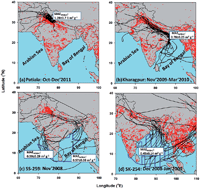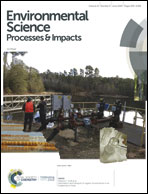Brown carbon in the continental outflow to the North Indian Ocean†
Abstract
In this paper, we synthesize the size distribution and optical properties of the atmospheric water-soluble fraction of light-absorbing organic carbon (brown carbon; BrC) in the continental outflow from the Indo-Gangetic Plain (IGP) in South Asia to the North Indian Ocean. A comparison of the mass absorption coefficient of water-soluble BrC (babs-WSBrC-365nm) in PM2.5 with that in PM10 sampled over the Bay of Bengal reveals the dominance of BrC in fine mode. Furthermore, the babs-BrC-365nm shows a significant linear relationship with mass concentrations of airborne particulate matter, water-soluble organic carbon and non-sea-salt-K+ in the continental outflow from the IGP. This observation emphasizes the ubiquitous nature and significant contribution of water-soluble BrC from biomass burning emissions (BBEs). Comparing the absorption properties from this study with global datasets, it is discernible that BBEs dominate BrC absorption. Furthermore, the imaginary refractive index of water-soluble BrC (kWSBrC-365nm) in marine aerosols sampled over the North Indian Ocean during November is significantly higher than during December to January. Thus, significant temporal variability is associated with crop-residue burning emissions in the IGP on the composition of BrC over the North Indian Ocean. Our estimates show that the babs-WSBrC-365nm and kWSBrC-365nm from post-harvest crop-residue burning emissions in the IGP are much higher than the BBEs from the southeastern United States and Amazonian forest fires. Another major finding of this study is the lack of significant relationship between kWSBrC-365nm and the mass ratio of elemental carbon to particulate organic matter, as previously suggested by chamber experiments to model varying BrC absorption properties in ambient aerosols. Therefore, considerable spatio-temporal variability prevails among emission sources (wood burning vs. crop-residue burning), which needs to be considered when assessing the regional radiative forcing of BrC relative to major absorbing elemental carbon.



 Please wait while we load your content...
Please wait while we load your content...